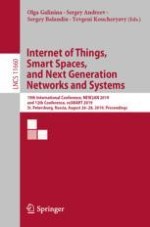This book constitutes the joint refereed proceedings of the 19th International Conference on Next Generation Teletraffic and Wired/Wireless Advanced Networks and Systems, NEW2AN 2019, and the 12th Conference on Internet of Things and Smart Spaces, ruSMART 2019.
The 66 revised full papers presented were carefully reviewed and selected from 192 submissions. The papers of NEW2AN address various aspects of next-generation data networks, with special attention to advanced wireless networking and applications. In particular, they deal with novel and innovative approaches to performance and efficiency analysis of 5G and beyond systems, employed game-theoretical formulations, advanced queuing theory, and stochastic geometry, while also covering the Internet of Things, cyber security, optics, signal processing, as well as business aspects.ruSMART 2019, provides a forum for academic and industrial researchers to discuss new ideas and trends in the emerging areas. The 12th conference on the Internet of Things and Smart Spaces, ruSMART 2019, provides a forum for academic and industrial researchers to discuss new ideas and trends in the emerging areas.
